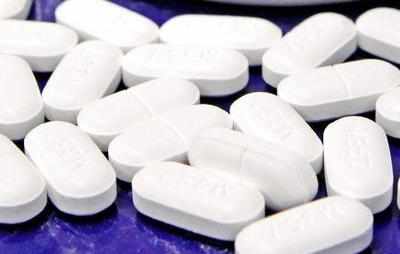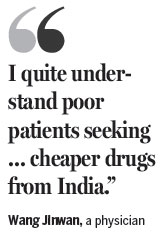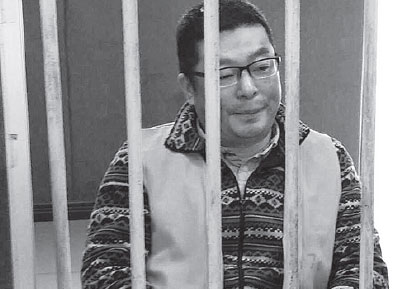It would have been a self-consolation had Chinese companies "
atleast" illegally copied Indian medicines and allowing Chinese citizens to fight cancer affordably.
But unfortunately, some Chinese drug makers prefer being slimey vermins who wish to make money by branding therir conterfiets as Indian drugs and exporting them to people in need
Made In India, Faked In China
Illegal Chinese manufacturers are faking drugs, endangering patients’ lives, and undermining legitimate brands, especially those from India. Bian Zhenjia, deputy commissioner of the Chinese State Food and Drug Administration (SFDA), told a news conference last year that reports claiming the country was a major exporter of fake drugs were unfair. “I don’t agree with what the foreign media has been saying. The Chinese government has always paid great attention to cracking down on fake drugs.”
But new data from the drug samplings that my research team has undertaken show that China is largely responsible for the fakes attributed to India. The sample sizes are small but indicative of a larger problem, a signal that New Delhi has every right to pressure Beijing to act on rogue manufacturers within its borders.
Indian companies provide vast amounts of generic drugs to mid-income and developing nations. By some estimates, 80% of HIV drugs for the developing world come from India, and probably half the antimalarials and antibiotics too.
Counterfeiters copy popular brands even when they’re not the most expensive, since the market accepts a familiar product more easily and without suspicion. This means many fakes may be sold before they are detected. And since Indian generics dominate many therapeutic categories of these markets, it is not surprising that they are the ones faked.
India has a problem with counterfeit and substandard drugs.
My research team collected drugs from 22 cities in 20 countries over the past four years. Of these, 911 antimalarial and antibiotic products were, according to their packaging, made in India. They were procured from 14 countries, mainly in Africa, but also in Thailand and India. Of those products, 79 (or 8.7%), failed basic quality control tests and hence were unfit for their intended use. Of these 79 products, we were able to establish that 37 were counterfeits. More products may have been counterfeit, but without responses from the manufacturers or regulatory agencies, it was not always possible to be sure. Of the 37 counterfeits identified, 22 were definitely faked in China and delivered straight to African nations from China. Hence, from our small sample, over half (59%) of the fake Indian drugs were actually made in China.
Dr Paul Orhii, head of Nigeria’s anti-counterfeit drug agency NAFDAC, helped us track where some of the alleged “Indian” fakes had come from. He told us of the astonishing Chinese criminal counterfeiting drug networks his investigators had unearthed. The networks are run from China and employ Nigerians and people of other nationalities. They have successfully infiltrated the entire supply and distribution chains–from producer to patient–across continents. Orhii said they either bribed employees of customs departments, or, in numerous instances, had their own personnel apply and get jobs in places ranging from Nigerian and Chinese customs to two Middle East airlines, which then unwittingly transported the fakes from China to Nigeria.
Each compliant official had responsibility at key parts of the distribution system, starting with manufacturing in the Chinese Shenzhen free-trade zone until they arrived in Lagos, Nigeria’s largest city. Remarkably, legitimate or unbribed officials had very little chance to spot the fakes being transported. In one instance, the drug traded by a gang was a fake of an Indian antimalarial drug called Lonart DS. The proper drug is made by Bliss Gvs Pharma Ltd, of Mumbai. The fake didn’t contain any of the correct active ingredients and had it been distributed, might have left untreated thousands of malaria-stricken children. Fortunately, this shipment was caught through routine surveillance work.
But this was not the only example in 2010 where a Chinese-made fake was passed off as an Indian generic in Nigeria, said Orhii. His department has clamped down on those selling fakes from China and now it inspects factories exporting drugs to Nigeria. As a result, Beijing has sentenced six Chinese nationals to death over their part in selling fake antimalarials. The sentence is yet to be carried out.
In 2009, our Nigerian colleague Thompson Ayodele came across another fake of an Indian drug, this time an antibiotic. Later, we found out that it, too, had been made in China.
But Chinese gangs do not discriminate whose drugs to fake. Indeed, every major drug company and every country has probably had drugs faked by the Chinese. They’ll fake anything popular. Take Artesunat, the brand of a Vietnamese antimalarial, made by the Ho Chi Minh-based Mekophar Chemical Pharmaceutical. Ongoing research shows that fake Artesunat was found in Nigeria, Ghana, Kenya, Uganda and Tanzania, and also in Thailand–all the handiwork of Chinese counterfeiters.
India has a problem with counterfeit and substandard drugs. Many are made by Indians for India’s market. But it may be less India’s fault than we thought. In addition to the examples discussed above, in our ongoing research, we have even come across Chinese fakes in India that sported “Made in India” labels.
Obviously, Beijing needs to improve oversight of drug production within its borders, but India must also act. Through the World Health Organization, it must push for strengthening of public health laws against trading fake drugs. It is in India’s interest, and of patients globally, to do so.
Roger Bate is the Legatum Fellow in Global Prosperity at AEI.
Photo Credit: iStockphoto/Jason Stitt
https://www.aei.org/publication/made-in-india-faked-in-china/
Smart of your ancestors to be pre-cognitive and migrate ahead of time
You have not changed one bit in racially abusing Pakistanis have you? How disgusting, but not surprising.
Pakistanis are humans too Andrew
Actions like these prove you are no different from Imperial Japanese who were racist to Chinese during century of humiliation.
I hope you think about what I have said and change for good.




















